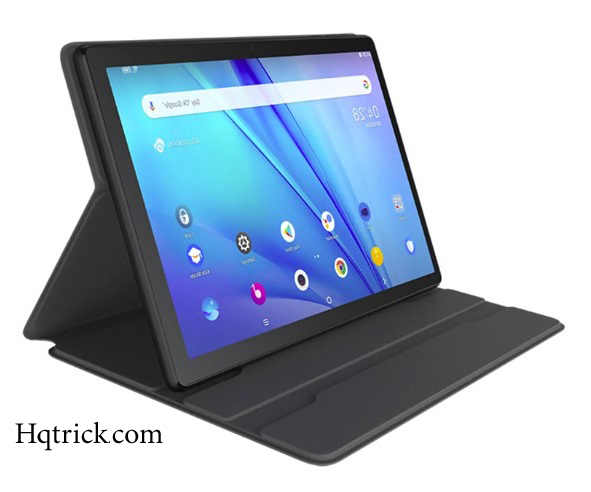A tablet is a type of portable computing device that typically features a touchscreen interface and is larger than a smartphone but smaller than a laptop or desktop computer.
Tablets are designed for on-the-go use and are commonly used for internet browsing, video watching, e-book reading, gaming, and running various applications.
Tablets come with different operating systems, such as iOS (used in Apple iPads), Android (used in tablets from various manufacturers), or Windows (used in some tablets designed for productivity).
If you are considering buying a new tablet, we will provide you with a comprehensive online guide to understand the different types, what to look for before making a purchase, and what you should know before taking that step.
How is a tablet computer different from a laptop or desktop computer?
Here are some advantages of tablets over regular computers and smartphones:
- Portability: Tablets are more portable than regular computers as they are smaller, lighter, and easier to carry around, making them convenient for on-the-go use.
- Touchscreen Interface: Tablets typically feature a touchscreen interface, providing a user-friendly and intuitive way to interact with the device, making them suitable for tasks such as drawing, handwriting, and gaming.
- Long Battery Life: Tablets often have longer battery life compared to laptops or smartphones, allowing for extended use without frequent recharging.
- Media: Tablets are optimized for media consumption, with larger screens compared to smartphones, making them ideal for watching videos, reading e-books, and browsing the internet.
- Apps: Tablets have access to a wide range of apps designed specifically for tablet use, providing diverse functionality for different tasks and purposes.
- Flexibility: Tablets can be used in various scenarios, such as work, entertainment, education, and communication, making them versatile devices for different use cases.
- Connectivity: Tablets often offer Wi-Fi and cellular connectivity options, providing flexibility in staying connected both at home and on the go.
What operating systems are available for tablets, and what are the differences between them?
The tablet operating system is the interface that users interact with, and it can vary significantly across different systems, impacting usability.
Here are some popular operating systems commonly found in tablets:
- Android
- iPad OS/IOS
- Windows
Android
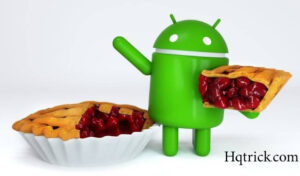
Android tablets are the best-selling tablets in the market, similar to smartphones. The Android operating system runs on devices from a variety of manufacturers, such as Samsung, Lenovo, Huawei, and Amazon, including the Fire Tablet series.
Most smartphone brands also offer tablets, which can result in differences in the user interface (UI) as each manufacturer adds their own customization to the Android operating system. These differences may be seen in application icons, home pages, or exclusive wallpapers. However, due to a large number of available devices, there are Android tablets in different price categories, ranging from low-end to mid-range to high-end devices. This allows users to choose a device that fits their needs, whether it’s for entertainment or powerful applications.
However, amidst this wide variety, there is a major drawback related to updates, especially in terms of security. When a new version of Android is released, it must be adapted by each manufacturer to its hardware and features, and the timing of these updates depends on the manufacturer. As a result, security updates may lag behind in some cases.
Huawei and Android:
Recently released Huawei tablets do not come with Google services, such as Google Maps and Google Playstore. This is due to the US government banning cooperation between US companies and Huawei, citing concerns about potential security risks.
iPad OS/IOS
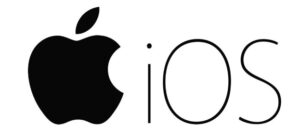
iPadOS, formerly known as iOS, is the operating system specifically designed for Apple’s iPad lineup.
While Apple’s tablets were not the first prototypes of tablet computers, they played a significant role in popularizing the concept of mobile computing.
Apple offers a limited selection of iPads, including the iPad, iPad mini, iPad Air, and iPad Pro, and the software has been meticulously optimized to work seamlessly with the internal hardware.
One of the key advantages of iPadOS is its close integration with other Apple devices. Data exchange via AirDrop, for example, is smooth and efficient, allowing users to transfer movies, photos, and other files wirelessly and quickly. Moreover, the powerful processors in Apple’s iPads enable users to take advantage of resource-intensive applications such as Photoshop and iMovie for direct media editing on the device.
The Apple ecosystem also offers a wide range of accessories for the iPad, further enhancing its functionality.
However, it should be noted that iPads and their accessories tend to be significantly more expensive than their competitors, reflecting the premium nature of Apple products. Nevertheless, the seamless synergy between iPadOS and Apple devices can be overwhelming for users who prioritize a cohesive and integrated experience across their Apple devices.
Windows

The Windows operating system is also available on tablets, although it is used by only a few manufacturers. As a result, Microsoft Surface is recommended as a choice for a tablet device, as it comes directly from the manufacturer with Windows and is positioned as a competitor to the iPad Pro.
Additionally, some users may find the angular design with a thicker black frame around the screen less modern, although this is a matter of personal preference.
However, Microsoft tablets have the advantage of a familiar user interface, which is similar to that of a desktop computer. This means that programs such as Microsoft Word or PowerPoint are widely available, making them convenient for users who extensively work with Microsoft programs and need easy access to their files on the go.
Processor
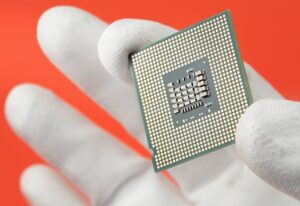
How much CPU power does a tablet need?
The CPU is the heart of a tablet as it determines the device’s performance. Android tablets usually come with Snapdragon processors, while iPads are based on A chipsets.
The actual performance of a CPU depends on two factors: the clock frequency measured in gigahertz (GHz) and the number of cores.
The idea can be approximated by considering the clock frequency as the horsepower of the engine, while the number of cores describes the number of cylinders.
In general, more cores are better because they allow for better power distribution, which in turn saves battery life and protects the processor.
For example, a processor with eight cores is usually better than one with only four cores.
- For internet browsing and social media use, a tablet with two to four cores is usually sufficient as these activities do not require much processing power. Choosing a more powerful processor will only increase the cost without offering significant benefits.
- For streaming services and students who may need to create extensive presentations or watch series and movies, a tablet with at least four cores is recommended to ensure smooth performance and prevent excessive battery consumption.
- For gamers who need high-performance tablets, it is recommended to use a device with the maximum number of cores and a high clock frequency. Only with a combination of the two can performance-intensive games be played smoothly without lag or delays.
RAM
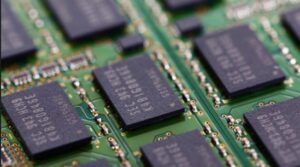
How much memory should a tablet have?
Memory, also known as RAM (Random Access Memory), is the short-term memory of a tablet computer.
It allows for caching of files on the tablet, such as when multiple apps are running simultaneously in the background. For example, you can use the picture-in-picture function to continue watching a video on Netflix while browsing the web. This requires the tablet to allocate memory to keep several programs open at the same time.
Having ample RAM also allows for faster app loading times and smoother multitasking, as apps can continue to run in the background without the need for a reboot. For this reason, it is recommended to use a tablet with as much RAM as possible for fast and smooth app performance.
- For internet browsing and occasional use, a tablet with at least 1GB of RAM is recommended.
- For users of streaming services and students who may need to use presentations and conduct research simultaneously, a tablet with at least 2GB of RAM is recommended.
- For professional users and gamers who require intensive memory usage for complex game worlds, a tablet with at least 4GB of RAM is recommended to fully enjoy high-performance gaming experiences.
Size and screen

Tablets mostly consist of a touch screen, which determines not only the screen size but also the overall size of the tablet.
A larger screen has the advantage of allowing more content to appear on the screen, making watching movies or videos more enjoyable. However, the screen should not be too large, as this may affect the portability of the tablet.
Many users see tablets as replacements for computers and take them to school, university, or work, so they shouldn’t be too big to fit in a backpack.
- For reading magazines, e-books, or browsing social media platforms, it is recommended to use a screen diagonal of at least 7 inches; otherwise, the tablet may resemble a smartphone.
- For mobile use at university, school, or for watching movies, a screen with a diagonal of at least 9 inches is ideal.
- Larger tablets up to 13 inches in diagonal may be less portable and are primarily suitable for home use in the living room or study, for media consumption, working on a tablet, or using streaming services.
What is the display sharpness and what resolution do I need?
Not only should you consider the size of the display, but also its sharpness or resolution. Resolution refers to the number of pixels per inch (ppi). The higher the number of pixels per inch, the sharper the display and its resolution. Manufacturers often specify resolution using terms like 720p, Full HD, or WQHD.
720p is the entry-level for high-definition displays. It has a resolution of 1280 x 720 pixels, which is sufficient for basic internet browsing and non-graphically demanding apps.
Full HD has a resolution of 1920 x 1080 pixels, making it much sharper. Tablets with Full HD resolution are ideal for streaming services and provide more vivid colors and detailed images.
WQHD, with a resolution of 2560 x 1440 pixels, is currently the highest available resolution on tablets, providing realistic images and videos.
However, the difference between Full HD and WQHD is only noticeable upon close inspection, which is why a Full HD display is more than sufficient for most buyers. Higher pixel density also requires more battery and GPU power, resulting in increased power consumption and potentially slower performance compared to Full HD displays.
How bright should the display be?
The maximum screen brightness is another important factor to consider when choosing a tablet. It is measured in candela per square meter (cd/m²).
A brighter display allows for better visibility of content under bright sunlight, but it also consumes more battery power. Therefore, it is recommended to look for a tablet with a minimum brightness of 400 cd/m² to ensure readability in sunny conditions, as our tests have shown that displays with lower brightness levels can be difficult to read in bright outdoor environments.
STORAGE :
How much storage space does a tablet need?
There are two types of memory in tablets: RAM (Random Access Memory) and internal storage. The approach to expandable memory differs between Apple devices and Android tablets, as Apple tablets do not support expandable storage, while many Android tablets, such as Samsung or Huawei, allow for internal storage expansion.
The amount of storage required depends on the number of files the user wants to store on the tablet. Most tablets come with built-in memory of around 32 GB, which is sufficient for storing some photos, videos, and applications. However, if you plan to store a lot of videos or larger apps, you may need additional storage through a microSD card or larger internal memory.
It’s important to note that Apple tablets do not support microSD cards for expansion, while most Android tablets have a dedicated slot for them. However, not all applications can be stored on a memory card, and some manufacturers, such as Samsung with the Tab S6 Lite, state that additional memory cannot be used for applications.
As a general guide, the following distribution of storage is recommended:
- Regular users: 64 GB
- Students: 64 – 256 GB
- Gamers / Videographers: 256 – 1000 GB
Battery :
What is the ideal battery life for a tablet?
The built-in battery is a crucial internal factor that significantly impacts the operating time of a tablet’s screen. A higher battery capacity, measured in milliampere-hours (mAh), generally results in longer battery life. However, other factors such as screen brightness, device performance, and power management settings also affect battery life.
On average, most tablets offer around six hours of battery life with normal use. It’s important to note that even tablets with a large mAh count may experience shorter battery life if the screen brightness is set to maximum, the device is running resource-intensive tasks, or power management settings are not optimized.
Factors like device usage patterns, screen brightness, and app usage can all impact battery life. It’s recommended to consider these factors and choose a tablet with a battery capacity that aligns with your specific needs.
If you plan to use the tablet extensively for tasks like gaming or video streaming, opting for a tablet with a larger battery capacity can ensure longer battery life without frequent recharging.
Tablet accessories
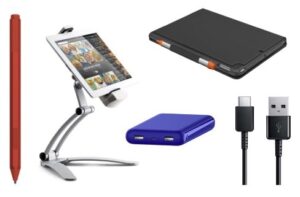
What are the helpful accessories for tablets?
Tablets are a single-display device that can be prone to damage in case of falls. Whether it’s an Apple, Samsung, or Huawei tablet, a fall resulting in display damage can be expensive to repair. Therefore, it is strongly recommended to use a suitable case that provides protection to the screen and prevents cracks.
For students, an integrated keyboard on the case can be particularly useful. Writing on a touch screen for long lectures or teaching sessions can be uncomfortable. Hence, a keyboard that connects via Bluetooth and charges through the tablet, eliminating the need for batteries or cables, can greatly enhance the usability of the tablet.
It’s important to choose a keyboard that is compatible with the tablet and offers a comfortable typing experience. In addition, other accessories such as screen protectors, stylus pens for drawing or note-taking, and a stand for propping up the tablet for viewing can also be useful additions to enhance the functionality and convenience of using a tablet.
